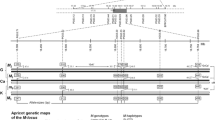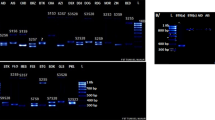Abstract
Self-compatibility has become the primary objective of most almond (Prunus amygdalus Batsch) breeding programmes in order to avoid the problems related to the gametophytic self-incompatibility system present in almond. The progeny of the cross ‘Vivot’ (S 23 S fa) × ‘Blanquerna’ (S 8 S fi) was studied because both cultivars share the same S f allele but have a different phenotypic expression: active (S fa) in ‘Vivot’ and inactive (S fi) in ‘Blanquerna’. In addition, the microscopic observation of pollen tube growth after self-pollination over several years showed an unexpected self-incompatible behaviour in most seedlings of this cross. The genotypes of this progeny showed that the S fi pollen from ‘Blanquerna’ was not able to grow down the pistils of ‘Vivot’ harbouring the S fa allele, confirming the active function of this allele against the inactive form of the same allele, S fi. As self-compatibility was observed in some S 8 S 23 and S 8 S fa individuals of this progeny, the S f haplotype may not always be linked to the expression and transmission of self-compatibility in almond, suggesting that a modifier locus may be involved in the mechanism of self-incompatibility in plants.




Similar content being viewed by others
References
Alonso JM, Socias i Company R (2005) Self-incompatibility expression in self-compatible almond genotypes may be due to inbreeding. J Am Soc Hortic Sci 130:865–869
Bošković R, Tobutt KR, Batlle I, Duval H (1997) Correlation of ribonuclease zymograms and incompatibility genotypes in almond. Euphytica 97:167–176
Bošković R, Tobutt KR, Duval H, Batlle I, Dicenta F, Vargas FJ (1999) A stylar ribonuclease assay to detect self-compatible seedlings in almond progenies. Theor Appl Genet 99:800–810
Bošković R, Tobutt KR, Ortega E, Sutherland BG, Godini A (2007) Self-(in)compatibility of the almonds P. dulcis and P. webbii: detection and cloning of ‘wild-type S f’ and new self-compatibility alleles encoding inactive S-RNases. Mol Genet Genomics 278:1617–4615
Channuntapipat C, Wirthensohn M, Ramesh SA, Batlle I, Arús P, Sedgley M, Collins G (2003) Identification of incompatibility genotypes in almond (Prunus dulcis Mill.) using specific primers based on the introns of the S-alleles. Plant Breed 122:164–168
Crossa-Raynaud P, Grasselly C (1985) Existence de groupes d’interstérilité chez l’amandier. Options Méditerr CIHEAM/IAMZ 85/I:43–45
de Nettancourt D (2001) Incompatibility and incongruity in wild and cultivated plants. Springer, Berlin
Dicenta F, García JE (1993) Inheritance of self-compatibility in almond. Heredity 70:313–317
Doyle JJ, Doyle JL (1987) A rapid DNA isolation procedure for small quantities of fresh leaf tissue. Phytochem Bull 19:11–15
Entani T, Iwano M, Shiba H, Che FS, Isogai A, Takayama S (2003) Comparative analysis of the self-incompatibility (S-)locus region of Prunus mune: identification of a pollen-expressed F-box gene with allelic diversity. Genes Cells 8:203–213
Espiau MT, Ansón JM, Socias i Company R (2002) The almond germplasm bank of Zaragoza. Acta Hortic 591:275–278
Felipe AJ (1977) El almendro: estados fenológicos. Inf Técn Econ Agrar 27:8–9
Fernández i Martí A, Alonso JM, Kodad O, Socias i Company R (2008) Differential phenotypic expression of self-compatibility in almond. Fourth International Rosaceae Genomics Conference (RGC4). Pucon, Chile, March 2008
Fernández i Martí A, Alonso JM, Hanada T, Yamane H, Tao R, Socias i Company R (2009) The S f haplotype of almond shows two different phenotypic expressions (in press)
Grasselly C, Crossa-Raynaud P, Olivier G, Gall H (1981) Transmission du caractère d’autocompatibilité chez l’amandier (Amygdalus communis). Options Méditerr CIHEAM/IAMZ 81/I:71–75
Hanada T, Fukuta K, Yamane H, Esumi T, Gradziel TM, Dandekar AM, Fernández i Martí A, Alonso JM, Socias i Company R, Tao R (2009) Cloning and characterization of self-compatible S f haplotype in almond (Prunus dulcis (Mill.) D.A. Webb.). HortScience 44:609–613
Hinata K, Watanabe M, Yamakawa S, Satta Y, Isogai A (1995) Evolutionary aspects of the S-related genes of the Brassica self-incompatibility system: synonymous and nonsynonymous base substitutions. Genetics 140:1099–1104
Hua Z, Kao T (2006) Identification and characterization of components of a putative Petunia S-locus F-Box-containing E3 ligase complex involved in S-RNase-based self-incompatibility. Plant Cell 18:2531–2553
Kodad O, Socias i Company R (2006) Pollen source effect on pollen tube growth in advanced self-compatible almond selections (Prunus amygdalus Batsch). Adv Hortic Sci 20:256–261
Kodad O, Alonso JM, Sánchez A, Oliveira M, Socias i Company R (2008) Evaluation of genetic diversity of S-alleles in an almond germplasm collection. J Hortic Sci Biotechnol 83:603–608
Kodad O, Socias i Company R, Sánchez A, Oliveira MM (2009) The expression of self-compatibility in almond may not only be due to the presence of the S f allele. J Am Soc Hortic Sci 134:221–227
Lai Z, Ma W, Han B, Liang L, Zhang Y, Hong G, Xue Y (2002) An F-box gene linked to self-incompatibility (S) locus of Antirrhinum is expressed specifically in pollen and tapetum. Plant Mol Biol 50:29–42
Lewis CI, Crowe LK (1954) The induction of self-fertility in tree fruits. J Hortic Sci 29:220–225
Marchese A, Bošković RI, Caruso T, Raimondo A, Cutuli M, Tobutt K (2007) A new self-compatibility haplotype in the sweet cherry ‘Kronio’, S ′ 5 , attributable to a pollen-part mutation in the SFB gene. J Exp Bot 58:4347–4356
McClure BA, Mou B, Canevascini S, Bernatzky R (1999) A small asparagine-rich protein required for S-allele specific pollen rejection in Nicotiana. Proc Natl Acad Sci USA 96:13548–13553
Ortega E, Bošković R, Sargent DJ, Tobutt KR (2006) Analysis of S-RNase alleles of almond (Prunus dulcis): characterization of new sequences, resolution of synonyms and evidence of intragenic recombination. Mol Gen Genomics 276:413–426
Romero C, Vilanova S, Burgos L, Martínez-Calvo J, Vicente M, Llácer G, Badenes ML (2004) Analysis of the S-locus structure in Prunus armeniaca L. Identification of S-haplotype specific S-RNase and F-box genes. Plant Mol Biol 56:145–157
Royo J, Kunz C, Kowyama Y, Anderson M, Clarke AE, Newbigin E (1994) Loss of a histidine residue at the active site of S-locus ribonuclease is associated with self-compatibility in Lycopersicon peruvianum. Proc Natl Acad Sci USA 91:6511–6514
Rubí V (1980) El almendro. Delegación de Baleares, Ministerio de Agricultura, Palma de Mallorca, Spain
Sassa H, Hirano H, Nishio T, Koba T (1997) Style-specific self-incompatibility mutation caused by deletion of the S-RNase gene in Japanese pear (Pyrus serotina). Plant J 12:223–227
Socias i Company R (1984) A genetic approach to the transmission of self-compatibility in almond. Options Méditerr CIHEAM/IAMZ 84/II:123–128
Socias i Company R (1990) Breeding self-compatible almonds. Plant Breed Rev 8:313–318
Socias i Company R (2002) Latest advances in almond self-compatibility. Acta Hortic 591:205–212
Socias i Company R (2004) The contribution of Prunus webbii to almond evolution. Plant Genet Resour Newsl 14:9–13
Socias i Company R, Felipe AJ (1999) ‘Blanquerna’, ‘Cambra’ y ‘Felisia’: tres nuevos cultivares autógamos de almendro. Inf Técn Econ Agrar 95V:111–117
Socias i Company R, Gómez Aparisi J, Alonso JM (2005) Year and enclosure effects on fruit set in an autogamous almond. Sci Hortic 104:369–377
Sonneveld T, Tobutt KF, Robbins TP (2003) Allele-specific PCR detection of sweet cherry self-incompatibility (S) alleles S 1 to S 16 using consensus and allele-specific primers. Theor Appl Genet 107:1059–1070
Sonneveld T, Tobbut KR, Vaughan SP, Robbins TP (2005) Loss of pollen-S function in two self-compatible selections of Prunus avium is associated with deletion/mutation of an S haplotype-specific F-box gene. Plant Cell 17:35–51
Sutherland BG, Robbins TP, Tobutt KR (2004) Primers amplifying a range of Prunus S-alleles. Plant Breed 123:582–584
Tao R, Yamane H, Sassa H, Mori H, Gradziel TM, Dandekar AM, Sugiura A (1997) Identification of stylar RNases associated with gametophytic self-incompatibility in almond (Prunus dulcis). Plant Cell Physiol 38:304–311
Tao R, Watari A, Hanada T, Habu T, Yaegaki H, Yamaguchi M, Yamane H (2007) Self-compatible peach (Prunus persica) has mutant versions of the S haplotypes found in self-incompatible Prunus species. Plant Mol Biol 63:109–123
Thompson KF, Taylor JP (1971) Self-compatibility in kale. Heredity 27:459–471
Tsukamoto T, Ando T, Kokubun H, Watanabe H, Sato T, Masada M, Marchesi E, Kao TH (2003) Breakdown of self-incompatibility in a natural population of Petunia axillaris caused by a modifier locus that suppresses the expression of an S-RNase gene. Sex Plant Reprod 15:255–263
Ushijima K, Sassa H, Dandekar MA, Gradziel TM, Tao R, Hirano H (2003) Structural and transcriptional analysis of the self-incompatibility locus of almond: identification of a pollen-expressed F-box gene with haplotype-specific polymorphism. Plant Cell 15:771–781
Ushijima K, Yamane Y, Watari A, Kakehi E, Ikeda K, Huak RH, Iezzoni AF, Tao R (2004) The S-haplotype-specific F-Box protein gene, SFB, is defective in self-compatible haplotypes of Prunus avium and P. mume. Plant J 39:573–586
Vilanova S, Badenes ML, Burgos L, Martínez-Calvo J, Llácer G, Romero C (2006) Self-compatibility of two apricot selections is associated with two pollen part mutations of different nature. Plant Physiol 142:629–641
Watari A, Hanada T, Yamane H, Esumi T, Tao R, Yaegaki H, Yamaguchi M, Beppu K, Kataoka I (2007) A low transcriptional level of S e-RNase in the S e-haplotype confers self-compatibility in Japanese plum. J Amer Soc Hortic Sci 132:396–406
Wünsch A, Hormaza JI (2004) Genetic and molecular analysis in Cristobalina sweet cherry, a spontaneous self-compatible mutant. Sex Plant Reprod 17:203–210
Yamane H, Ushijima K, Sassa H, Tao R (2003a) The use of S haplotype-specific F-box protein gene, SFB, as a molecular marker for S-haplotypes and self-compatibility in Japanese apricot (Prunus mume). Theor Appl Genet 107:1357–1361
Yamane H, Ikeda K, Ushijima K, Sassa H, Tao R (2003b) A pollen-expressed gene for a novel protein with an F-motif that is very tightly linked to a gene for S-RNase in two species of cherry, Prunus cerasus and P. avium. Plant Cell Physiol 44:764–769
Yates F (1934) Contingency tables involving small numbers and the Chi-squared test. J R Stat Soc Suppl 1:217–235
Acknowledgments
This research was conducted under the Spanish CICYT project AGL2007-65853-C0202 and the activity of the Research Group A12 of Aragón. A. Fernández i Martí acknowledges the scholarship co-funded by the Spanish “Ministerio de Educación y Ciencia” and the European Social Fund (FSE), under projects AGL 2004-06674-C02-01 and BES-2006-12621.
Author information
Authors and Affiliations
Corresponding author
Additional information
Communicated by Teh-hui Kao.
Rights and permissions
About this article
Cite this article
Fernández i Martí, A., Hanada, T., Alonso, J.M. et al. A modifier locus affecting the expression of the S-RNase gene could be the cause of breakdown of self-incompatibility in almond. Sex Plant Reprod 22, 179–186 (2009). https://doi.org/10.1007/s00497-009-0102-7
Received:
Accepted:
Published:
Issue Date:
DOI: https://doi.org/10.1007/s00497-009-0102-7




